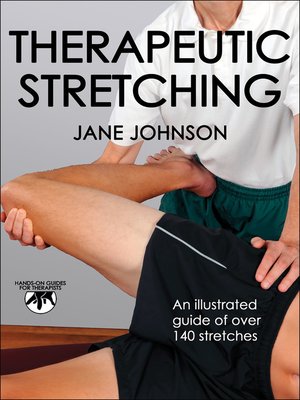
Sign up to save your library
With an OverDrive account, you can save your favorite libraries for at-a-glance information about availability. Find out more about OverDrive accounts.
Find this title in Libby, the library reading app by OverDrive.



Search for a digital library with this title
Title found at these libraries:
| Loading... |
Therapeutic Stretching focuses on the use of both active and passive stretching as part of the rehabilitation of common musculoskeletal conditions and injuries. Covering all forms of stretches for the able-bodied, injured, and selected special populations, Therapeutic Stretching is a comprehensive resource for practitioners and students working in massage therapy, osteopathy, physical therapy, occupational therapy, rehabilitation, and personal and athletic training.
With both active and passive stretches outlined for a range of musculoskeletal conditions and injuries, Therapeutic Stretching offers a range of rehabilitative stretches for the foot and ankle, knee and leg, hip and thigh, upper limb, shoulder, elbow, wrist, hand and fingers, and back and neck. Author Jane Johnson, a practicing physiotherapist, sport massage therapist, and body work instructor, provides information on incorporating passive stretching as a treatment option and selecting appropriate active stretches for clients to practice at home.
Heavily illustrated with more than 230 color photos, Therapeutic Stretching provides excellent visual instruction on client positioning and the most effective handholds for the application of passive stretches to various joints and soft tissues. A user-friendly format, clear explanations of stretching techniques, and visual guidance from photos help students and practitioners readily incorporate these stretches into their practice.
Therapeutic Stretching outlines the rationale for stretching after musculoskeletal injury along with general safety guidelines and an overview of the musculoskeletal conditions addressed in the text. Also included is a discussion of the differences between and applications of passive, active, and advanced forms of stretching such as muscle energy technique (MET) and soft tissue release (STR).
Readers of Therapeutic Stretching will find a 10-step process for designing, implementing, and assessing a stretching program. The text discusses applications of therapeutic stretching for three special populations: elderly clients, pregnant women, and athletes. For each, a listing of common physiological factors or characteristics that might affect a stretching program is included, along with tips on modifications to employ when working with these individuals.
Following this foundational information are three chapters with photos and descriptions of active and passive stretches for musculoskeletal injuries and conditions of the lower limbs, upper limbs, and trunk. Here readers will find stretches useful for treating injuries and conditions such as sprained ankles, shin splints, runner's knee, tight calves or hamstrings, adhesive capsulitis, lateral epicondylitis, stiff wrists, kyphosis, low back pain, stiff neck, and whiplash.
Special Tip boxes throughout the text offer guidance on modifying the stretches and techniques to meet the needs of individual clients. Tables detail the passive and active stretches covered in each chapter and indicate whether a stretch is contraindicated for a particular injury or condition. Following most chapters are five Quick Questions that assist readers in gauging their understanding of the content.
In addition, Therapeutic Stretching includes a visual guide to stretching routines that could be performed in the prone, supine, and seated positions. These suggested routines assist students and practitioners new to therapeutic stretching in learning to apply these stretches in an...






